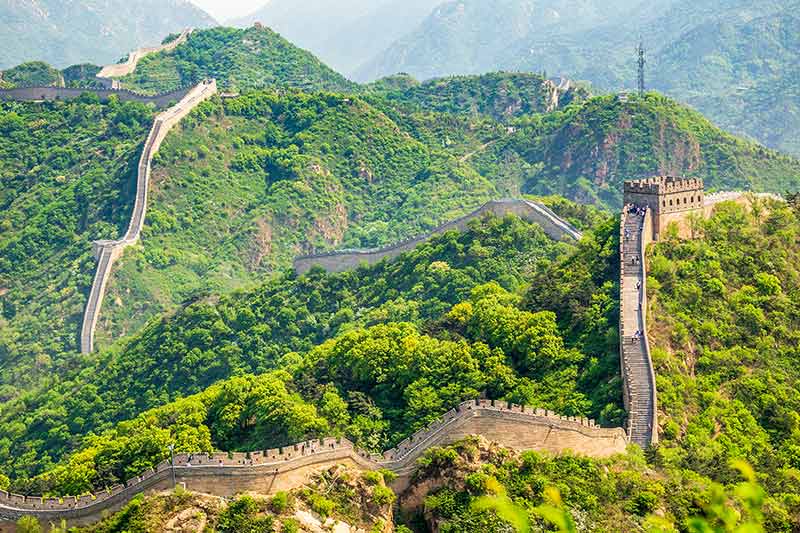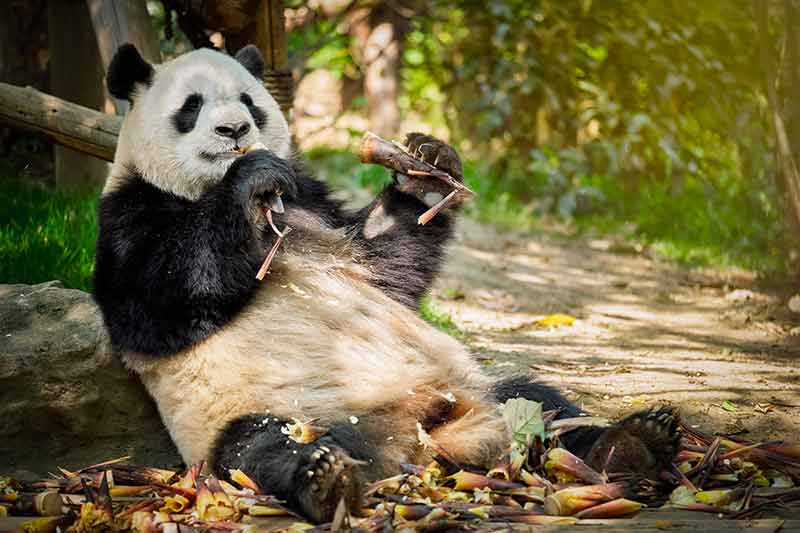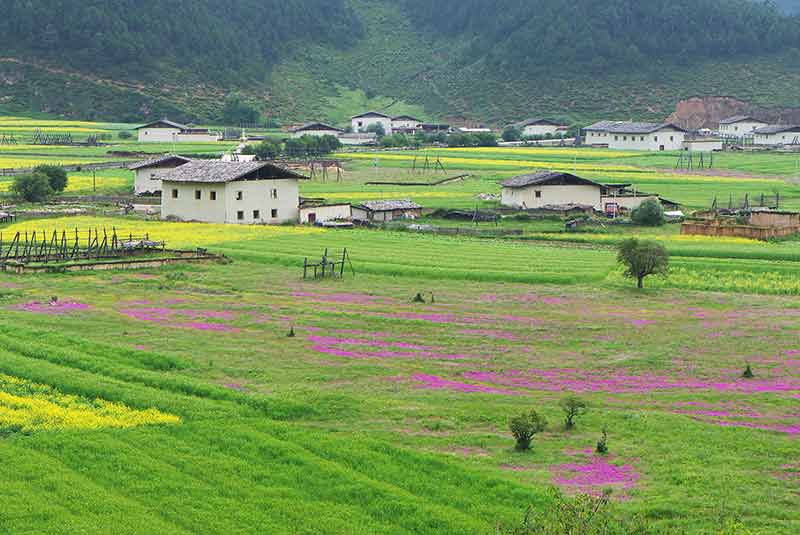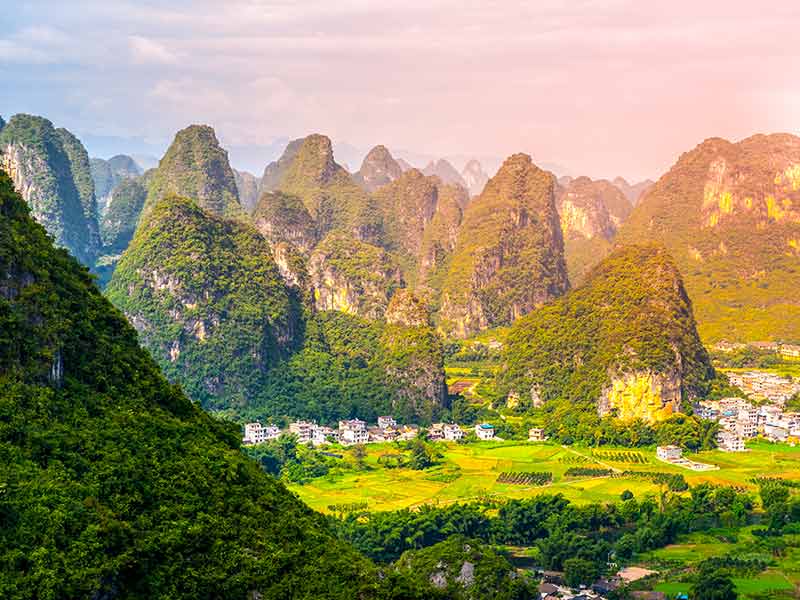China is often known for its modern, highly populated cities but China is so large that much of it is covered in countryside and incredible national parks and scenic areas. There are so many stunning natural landscapes to discover in China that you may very well utilize the full 90-day tourist visa. However, in this article you can find a jam-packed two-week itinerary to some of the unmissable wildlife spots in China. Starting in the north in China’s capital Beijing and then heading southwest to Chengdu, southwest again to Yunnan and finally ending in Guangxi Province this trip takes you to some fascinating parts of China.
Contents
China Itinerary – Nature And Wildlife
China is one of those places where you really can spend a long time there. With many countries citizens being able to option a 90-day tourist visa you also have some flexibility to extend your itinerary. But if you want to have a compact two week itinerary then it is suggested to follow this trip schedule.
- Beijing – 4 days
- Chengdu – 3 days
- Shangri-la/ Lijiang – 3 days
- Guilin – 4 days
Day 1 to 4 – Beijing
The Great Wall of China – Beijing

It is hard to travel to China and resist visiting the country’s most iconic landmark…the Great Wall of China.
The Great Wall is 21,196 km (13,170 mi) long and stretches from the sea in the east to the desert in the northwest and it took a whopping 2,000 years plus to build!
Considering the Great Wall’s size, it might be daunting to figure out which is the best section to go to.
If you are flying to China, then chances are you will want to see some of the country’s iconic places.
Heading to Beijing gives you the opportunity to look around the city and visit the Mutianyu Section of the Great Wall.
Mutianyu is in Huairou County around 73 km (45 mi) from Beijing’s city center.
It’s a less crowded section of the Great Wall compared to places like Badaling.
The surrounding views of mountains are enough to satisfy any visitor.
You can hike along the wall heading up steep sections and to the iconic watch towers.
You can even ride a cable car and go on the toboggan ride down from the top of the wall.
Reaching the Mutianyu section from Beijing is easy.
The simple and affordable option is to take the tourist bus from Qianmen or Dongzhimen.
This bus costs just 80 RMB ($11) for a round trip or you can join an organised tour or a private tour with a VIP pass to skip the lines.
You can take the even cheaper 12 RMB ($1.66) 916 Express bus as well.
For more comfort and convenience, you can take a taxi or a DiDi (China’s equivalent of Uber).
A ride in a DiDi will cost around 220 RMB ($30) or if you’re short on time, a private roundtrip transfer is the most convenient option.
You can purchase tickets for the wall when you arrive, they cost around 40 RMB ($5.53) plus 20RMB ($2.76) for the shuttle bus to reach the base of the wall.
Don’t cheap out and skip the bus, you’ll want to get to the wall in plenty of time to make the most of hiking on top where the views are spectacular.
If you are looking for an alternatively and equally stunning section of the Great Wall to visit, consider heading to Jiankou.
The word Jiankou means “arrow nock” because of the mountain’s shape.
It is kind of crazy to see that they built a wall along this impressive ridge.
This section zigzags 12 miles (20 km) joining Mutianyu and Huanghuacheng.
This is a section of the Great Wall that is most suited to hikers and those who have a strong sense of adventure.
This section is steep and coupled with the humid summer temperatures you better come prepared.
To reach Jiankou from downtown Beijing you can take the 916 Express bus to Xizhazi Village (northern foot of Jiankou) or to Wofo Villa (southern foot of Jiankou).
Day 5 to 7 – Chengdu
Chengdu Research Base of Giant Panda Breeding – Chengdu, Sichuan Province

From Beijing you can fly or take the fast train to Chengdu.
The quickest train from Beijing West station to Chengdu East takes around 7 hours 30 minutes and costs around 840 RMB ($115).
Flights are similarly priced at around 850 RMB but are much quicker at under 3 hours ($117).
Chengdu is a city you can spend at least three or four days in.
From some of the spiciest food in China to the crown and jewel… the giant panda.
There is so much to see and do in the city.
Pandas are synonymous with China, and they are treasured by the country and their people.
The Chengdu Research Base of Giant Panda Breeding is situated in the northern suburbs around 16 km from the city center (9.9 mi).
You can reach the research base by DiDi or taxi which can cost around 40-60 RMB ($5.50-8:30).
Cheaper options include taking the Panda Express Bus that leaves from Wuhou Temple (Line 1), Kuanzhai Alley (Line 2) and Chunxi Road (Line 3).
For those who love wildlife but don’t like zoos, the Chengdu Research Base of Giant Panda Breeding is a good compromise.
It does have a certain “zoo-like” feel to it simply because there are people there looking for pandas.
However, they have worked hard to replicate pandas’ real-life environments.
There’s also no arguing with the population increase statistics.
In the 1980s there were around 1,100 giant pandas in the wild and today this number is around 1,900.
The research center has undertaken more than 400 scientific and popularization projects by the end of 2022.
Their central aim is to allow the giant panda population to increase and flourish.
There are more than 100 pandas at the base.
The base has been set up to resemble the panda’s natural habitat and the 92-acre park has more than 96% plant coverage.
There’s a panda cub nursery, a giant panda museum and the breeding center.
There are also red pandas and black-necked cranes.
If you are not an early morning person then become one for this trip because if you arrive after 10am then you probably won’t see pandas doing anything more than sleep.
In the morning after feeding time, they are more active.
You can purchase tickets before heading to the research base but bring your passport just in case for other ticket purchases or verifications. If you want to be sure you’ll get to see the giant pandas, then a half-day tour is your best bet.
After visiting the adorable giant pandas, you can explore the city, try an incredible Sichuan hot pot, watch the Sichuan Opera, visit temples and check out the famous Anshun Bridge. A trip to the Giant Buddha in Leshan is also worth doing from Chengdu.
For more things to do in China read:
- 25 Famous Landmarks in China
- Best Time To Visit China
- 20 Ways To Celebrate Christmas In China
- 20 China Beaches For Your Bucket List
- 20 Things To Do In Shanghai At Night
- 20 Things To Do In Guangzhou
- 21 Places To Visit In China
- 7 Things To Do In Xiamen
- 20 Things To Do In Xian
- Yangtze River Cruise
- Inner Mongolia In Winter
- Places To Visit In Yunnan
- 20 Things To Do In Beijing At Night
- 20 Smart Cities in China
- Winter in China – 20 Things To Do
- 15 Things China Is Famous For
- Living in China – Everything You Need To Know
- 20 Endemic Animals In China And Where To See Them
- 12 National Parks in China
- 20 Things To Do In Chengdu At Night
- 20 Things To Do In Chongqing At Night
Day 8 to 10 – Shangri-la
Tacheng Black Snub-Nosed Monkey National Park – Shangri-la, Yunnan Province

Beijing and Chengdu are not new cities to overseas visitors but checking out the Tacheng Black Snub-Nosed Monkey National Park is one of the most unique wildlife experiences to have in China.
This national park is in northern Yunnan Province in southwestern China.
As far as the size of China goes its relatively close to Chengdu but how to get there?
The park is in Tacheng Town in Weixi County.
This park is 120 km (74 mi) from Shangri-la city and 150 km (93 mi) from Lijiang (both equally beautiful cities).
From either of these two cities there are public buses that take you to the national park.
Now… onto the monkeys.
There are two types of snub-nosed monkeys: the black and the white.
At this park there are between 20 and 60 black snub-nosed monkeys.
These monkeys are native to the alpine coniferous forests of Tibet and Yunnan.
The snub-nosed monkey has previously been threatened by habitat loss and hunting so to see them today is a real treat.
While the golden snub-nosed monkey numbers are between 8,000 and 10,000 the black and grey species number less than 1,500.
The park is not just home to the black snub-nosed monkey.
If you are incredibly lucky you might be able to see the golden pheasant (a truly stunning bird), black bears, other monkeys, and the clouded leopard (though sightings are incredibly rare).
Simply knowing you could see these animals has you walking around with your eyes on high alert.
To view the monkeys there is a specific spot halfway up the mountain (that stands at 3,000 m (9842 ft) above sea level).
At the entrance of the park there are sightseeing buses that take you up to this spot.
At 9-9:30 rangers feed the monkeys so this is the best time for viewing.
After eating the monkeys tend to head further up the mountain in search of more food.
If you get to the park around 11am you will probably not see any monkeys.
As you need to arrive early to see the monkey’s and Shangri-la and Lijiang are so far away it’s advisable to travel the day before and stay the night in Tacheng town.
In terms of the best time of year to visit the park, the Lapu Valley enjoys a relatively mild climate so it’s possible to visit in late spring and early summer but also in the snowy winter months too.
Day 11 to 13 – Guilin
Yangshuo Mountains – Guilin, Guangxi Province

To do the beautiful Yangshuo mountains justice you will want to leave around four days for this part of the trip.
The Yangshuo Mountains are close to Guilin in the autonomous region of Guangxi.
The best way to reach Guilin is from Lijiang via airplane.
Flights take around two hours and cost around 600 RMB ($82).
The stunning and intriguing Yangshuo Mountains sit around 65 km (40 mi) southeast of Guilin.
The karst landform hills are seemingly never-ending and coupled with the meandering Li River this really is a beautiful place to visit.
There are a plethora of things to see and do in Yangshuo and you will definitely want to make use of the four days in the area.
Taking a cruise or boat tour along the Li River is one of the best ways to see these stunning karst landforms.
You should also head up Xianggong Hill for stunning views of the river, mountains, and countryside.
Moon Hill is another excellent spot to see a naturally formed cavern.
The cave hole looks like a moon, hence its name.
It takes around one or two hours to visit this mountain and once at the top you will be rewarded with a wonderful 360 degree panoramic view of Yangshuo County.
Another excellent place to visit is Xingping Ancient Town.
A visit to this ancient town allows you to understand what local life was like in such a rural community.
It’s the perfect place to enjoy nature and culture.
Wander along ancient streets, marvel at ancient buildings.
As well as seeing the scenery there are a variety of ways to move around.
You can ride bamboo rafts, go biking, enjoy rock climbing, walking, and hiking.
The Li River cruise is one of the most popular activities in the area.
These cruises start in Guilin and head down to the Yangshuo area, taking around four or five hours.
Yangshuo is a fantastic example of the Chinese countryside.
While you are there you will see fishermen using traditional bamboo boats to catch fish, birds flying in the sky and even buffalos going to the water to drink.
If you are searching for an iconic Chinese countryside experience, there is no place better than Guilin and Yangshuo.
China is a large country with an epic array of landscapes.
From epic and crowded cities like Beijing, Shanghai, and Guangzhou to rural areas like Yangshuo and Yunnan Province China is bursting with new places to discover.
This two-week nature and wildlife itinerary gives you a glimpse into the different landscapes in China.
If you plan on staying in China for longer you can add to this two-week itinerary.
Other top nature places to view wildlife and connect with nature include Zhangjiajie in Hunan Province, Jiuzhai Valley National Park in Sichuan Province, and the Huangshan Mountains (Yellow Mountains) in Anhui Province.
While it is true that travel in China’s countryside is a little more complicated than in the city it is well worth venturing out to the rural areas because you simply cannot beat some of the otherworldly views you will see.
Looking for more itineraries? Try these:
- 10-day Japan Itinerary
- Osaka Itinerary
- The Perfect Nagoya Itinerary
- Hong Kong Itinerary
- Macau Itinerary
- Taiwan Itinerary
- 5-day Beijing Itinerary
- 7-day Greece Itinerary
- 10-day Portugal Itinerary
- 3-day Paris Itinerary
- 10-day France Itinerary
- 10-day Southern Spain Itinerary
- 10-day Northern Spain Itinerary
- 10-day Ireland Itinerary
- 3-day Athens Itinerary
- 10-day Iceland Itinerary
- 10-day Thailand Itinerary
- Bali Itinerary
- San Francisco Itinerary
- Oahu Itinerary
- Galapagos Islands Itinerary
- Sweden Itinerary
- Balkan Itinerary
- Tasmania Itinerary
- Sri Lanka Itinerary
- Philippines Itinerary
- 3-day Shanghai Itinerary
- 10-day China Itinerary (Wildlife/Nature)
- 3-day Lisbon Itinerary
- 3-day Porto Itinerary
- 7-day Tuscany Itinerary
- 5-day Tokyo Itinerary
Plan Your Trip

Rent A Car – Find the best car rental rates at Discover Cars. They compare car hire companies to provide you with the best deal right now.

Find A Hotel – If you’re curious about this article and are looking for somewhere to stay, take a look at these amazing hotels.

